
In graph theory, a graph property or graph invariant is a property of graphs that depends only on the abstract structure, not on graph representations such as particular labellings or drawings of the graph. [1]

In graph theory, a graph property or graph invariant is a property of graphs that depends only on the abstract structure, not on graph representations such as particular labellings or drawings of the graph. [1]
While graph drawing and graph representation are valid topics in graph theory, in order to focus only on the abstract structure of graphs, a graph property is defined to be a property preserved under all possible isomorphisms of a graph. In other words, it is a property of the graph itself, not of a specific drawing or representation of the graph. Informally, the term "graph invariant" is used for properties expressed quantitatively, while "property" usually refers to descriptive characterizations of graphs. For example, the statement "graph does not have vertices of degree 1" is a "property" while "the number of vertices of degree 1 in a graph" is an "invariant".
More formally, a graph property is a class of graphs with the property that any two isomorphic graphs either both belong to the class, or both do not belong to it. [1] Equivalently, a graph property may be formalized using the indicator function of the class, a function from graphs to Boolean values that is true for graphs in the class and false otherwise; again, any two isomorphic graphs must have the same function value as each other. A graph invariant or graph parameter may similarly be formalized as a function from graphs to a broader class of values, such as integers, real numbers, sequences of numbers, or polynomials, that again has the same value for any two isomorphic graphs. [2]
Many graph properties are well-behaved with respect to certain natural partial orders or preorders defined on graphs:
These definitions may be extended from properties to numerical invariants of graphs: a graph invariant is hereditary, monotone, or minor-closed if the function formalizing the invariant forms a monotonic function from the corresponding partial order on graphs to the real numbers.
Additionally, graph invariants have been studied with respect to their behavior with regard to disjoint unions of graphs:
In addition, graph properties can be classified according to the type of graph they describe: whether the graph is undirected or directed, whether the property applies to multigraphs, etc. [1]
The target set of a function that defines a graph invariant may be one of:
Easily computable graph invariants are instrumental for fast recognition of graph isomorphism, or rather non-isomorphism, since for any invariant at all, two graphs with different values cannot (by definition) be isomorphic. Two graphs with the same invariants may or may not be isomorphic, however.
A graph invariant I(G) is called complete if the identity of the invariants I(G) and I(H) implies the isomorphism of the graphs G and H. Finding an efficiently-computable such invariant (the problem of graph canonization) would imply an easy solution to the challenging graph isomorphism problem. However, even polynomial-valued invariants such as the chromatic polynomial are not usually complete. The claw graph and the path graph on 4 vertices both have the same chromatic polynomial, for example.
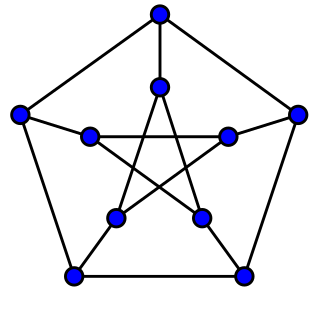
In the mathematical field of graph theory, the Petersen graph is an undirected graph with 10 vertices and 15 edges. It is a small graph that serves as a useful example and counterexample for many problems in graph theory. The Petersen graph is named after Julius Petersen, who in 1898 constructed it to be the smallest bridgeless cubic graph with no three-edge-coloring.

In graph theory, an isomorphism of graphsG and H is a bijection between the vertex sets of G and H
This is a glossary of graph theory. Graph theory is the study of graphs, systems of nodes or vertices connected in pairs by lines or edges.
In graph theory, the Robertson–Seymour theorem states that the undirected graphs, partially ordered by the graph minor relationship, form a well-quasi-ordering. Equivalently, every family of graphs that is closed under minors can be defined by a finite set of forbidden minors, in the same way that Wagner's theorem characterizes the planar graphs as being the graphs that do not have the complete graph K5 or the complete bipartite graph K3,3 as minors.
In graph theory, an undirected graph H is called a minor of the graph G if H can be formed from G by deleting edges, vertices and by contracting edges.
In theoretical computer science, the subgraph isomorphism problem is a computational task in which two graphs G and H are given as input, and one must determine whether G contains a subgraph that is isomorphic to H. Subgraph isomorphism is a generalization of both the maximum clique problem and the problem of testing whether a graph contains a Hamiltonian cycle, and is therefore NP-complete. However certain other cases of subgraph isomorphism may be solved in polynomial time.

In graph theory, a perfect graph is a graph in which the chromatic number equals the size of the maximum clique, both in the graph itself and in every induced subgraph. In all graphs, the chromatic number is greater than or equal to the size of the maximum clique, but they can be far apart. A graph is perfect when these numbers are equal, and remain equal after the deletion of arbitrary subsets of vertices.
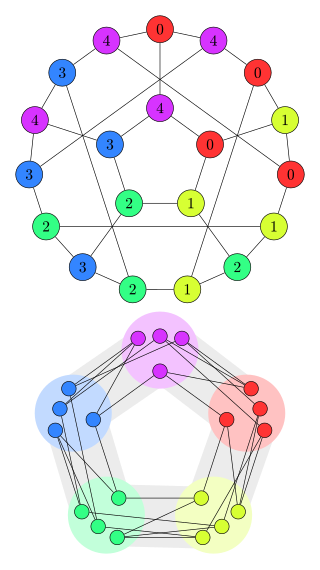
In the mathematical field of graph theory, a graph homomorphism is a mapping between two graphs that respects their structure. More concretely, it is a function between the vertex sets of two graphs that maps adjacent vertices to adjacent vertices.

In graph theory, a proper edge coloring of a graph is an assignment of "colors" to the edges of the graph so that no two incident edges have the same color. For example, the figure to the right shows an edge coloring of a graph by the colors red, blue, and green. Edge colorings are one of several different types of graph coloring. The edge-coloring problem asks whether it is possible to color the edges of a given graph using at most k different colors, for a given value of k, or with the fewest possible colors. The minimum required number of colors for the edges of a given graph is called the chromatic index of the graph. For example, the edges of the graph in the illustration can be colored by three colors but cannot be colored by two colors, so the graph shown has chromatic index three.
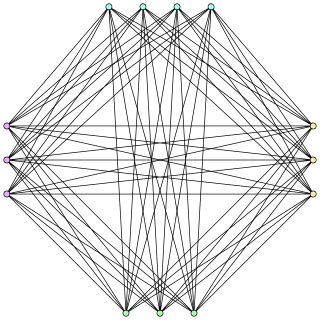
In graph theory, a cograph, or complement-reducible graph, or P4-free graph, is a graph that can be generated from the single-vertex graph K1 by complementation and disjoint union. That is, the family of cographs is the smallest class of graphs that includes K1 and is closed under complementation and disjoint union.

The chromatic polynomial is a graph polynomial studied in algebraic graph theory, a branch of mathematics. It counts the number of graph colorings as a function of the number of colors and was originally defined by George David Birkhoff to study the four color problem. It was generalised to the Tutte polynomial by Hassler Whitney and W. T. Tutte, linking it to the Potts model of statistical physics.
In computational complexity, problems that are in the complexity class NP but are neither in the class P nor NP-complete are called NP-intermediate, and the class of such problems is called NPI. Ladner's theorem, shown in 1975 by Richard E. Ladner, is a result asserting that, if P ≠ NP, then NPI is not empty; that is, NP contains problems that are neither in P nor NP-complete. Since it is also true that if NPI problems exist, then P ≠ NP, it follows that P = NP if and only if NPI is empty.
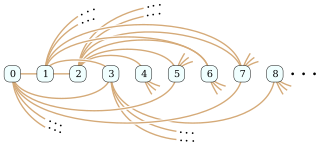
In the mathematical field of graph theory, the Rado graph, Erdős–Rényi graph, or random graph is a countably infinite graph that can be constructed by choosing independently at random for each pair of its vertices whether to connect the vertices by an edge. The names of this graph honor Richard Rado, Paul Erdős, and Alfréd Rényi, mathematicians who studied it in the early 1960s; it appears even earlier in the work of Wilhelm Ackermann. The Rado graph can also be constructed non-randomly, by symmetrizing the membership relation of the hereditarily finite sets, by applying the BIT predicate to the binary representations of the natural numbers, or as an infinite Paley graph that has edges connecting pairs of prime numbers congruent to 1 mod 4 that are quadratic residues modulo each other.
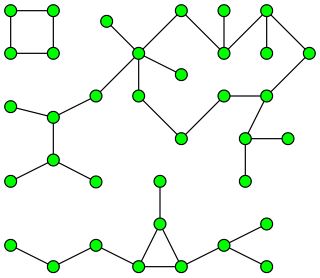
In graph theory, a pseudoforest is an undirected graph in which every connected component has at most one cycle. That is, it is a system of vertices and edges connecting pairs of vertices, such that no two cycles of consecutive edges share any vertex with each other, nor can any two cycles be connected to each other by a path of consecutive edges. A pseudotree is a connected pseudoforest.
Property testing is a field of theoretical computer science, concerned with the design of super-fast algorithms for approximate decision making, where the decision refers to properties or parameters of huge objects.
In the mathematical discipline of graph theory, the Erdős–Pósa theorem, named after Paul Erdős and Lajos Pósa, relates two parameters of a graph:

In the mathematical field of graph theory, the Clebsch graph is either of two complementary graphs on 16 vertices, a 5-regular graph with 40 edges and a 10-regular graph with 80 edges. The 80-edge graph is the dimension-5 halved cube graph; it was called the Clebsch graph name by Seidel (1968) because of its relation to the configuration of 16 lines on the quartic surface discovered in 1868 by the German mathematician Alfred Clebsch. The 40-edge variant is the dimension-5 folded cube graph; it is also known as the Greenwood–Gleason graph after the work of Robert E. Greenwood and Andrew M. Gleason, who used it to evaluate the Ramsey number R(3,3,3) = 17.
In graph theory, a family of graphs is said to have bounded expansion if all of its shallow minors are sparse graphs. Many natural families of sparse graphs have bounded expansion. A closely related but stronger property, polynomial expansion, is equivalent to the existence of separator theorems for these families. Families with these properties have efficient algorithms for problems including the subgraph isomorphism problem and model checking for the first order theory of graphs.
In the mathematical fields of graph theory and finite model theory, the logic of graphs deals with formal specifications of graph properties using sentences of mathematical logic. There are several variations in the types of logical operation that can be used in these sentences. The first-order logic of graphs concerns sentences in which the variables and predicates concern individual vertices and edges of a graph, while monadic second-order graph logic allows quantification over sets of vertices or edges. Logics based on least fixed point operators allow more general predicates over tuples of vertices, but these predicates can only be constructed through fixed-point operators, restricting their power.
In mathematics, a graph polynomial is a graph invariant whose value is a polynomial. Invariants of this type are studied in algebraic graph theory. Important graph polynomials include: